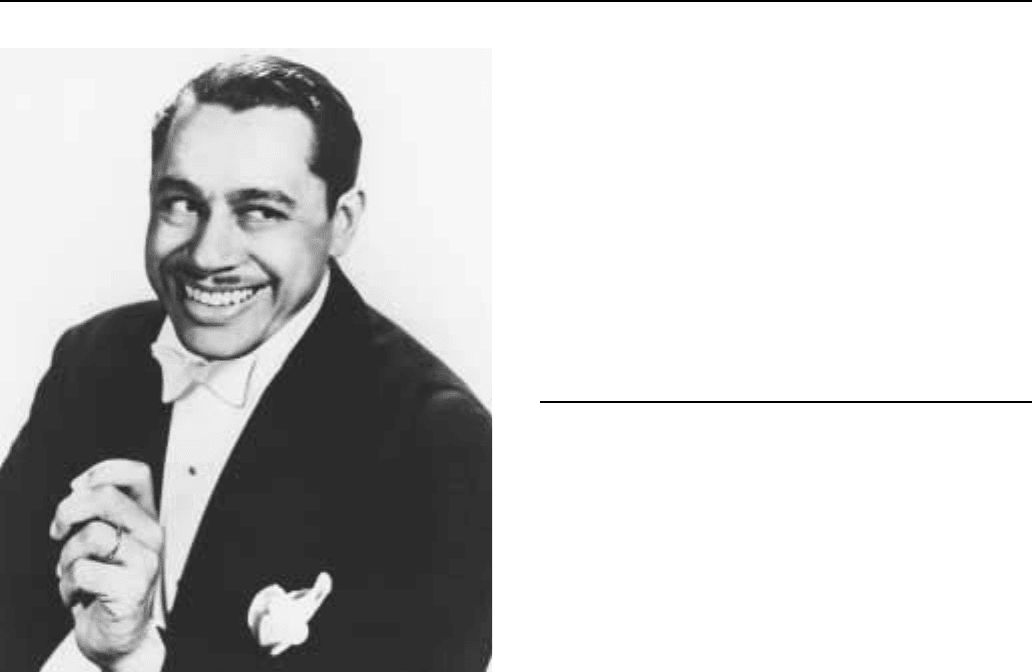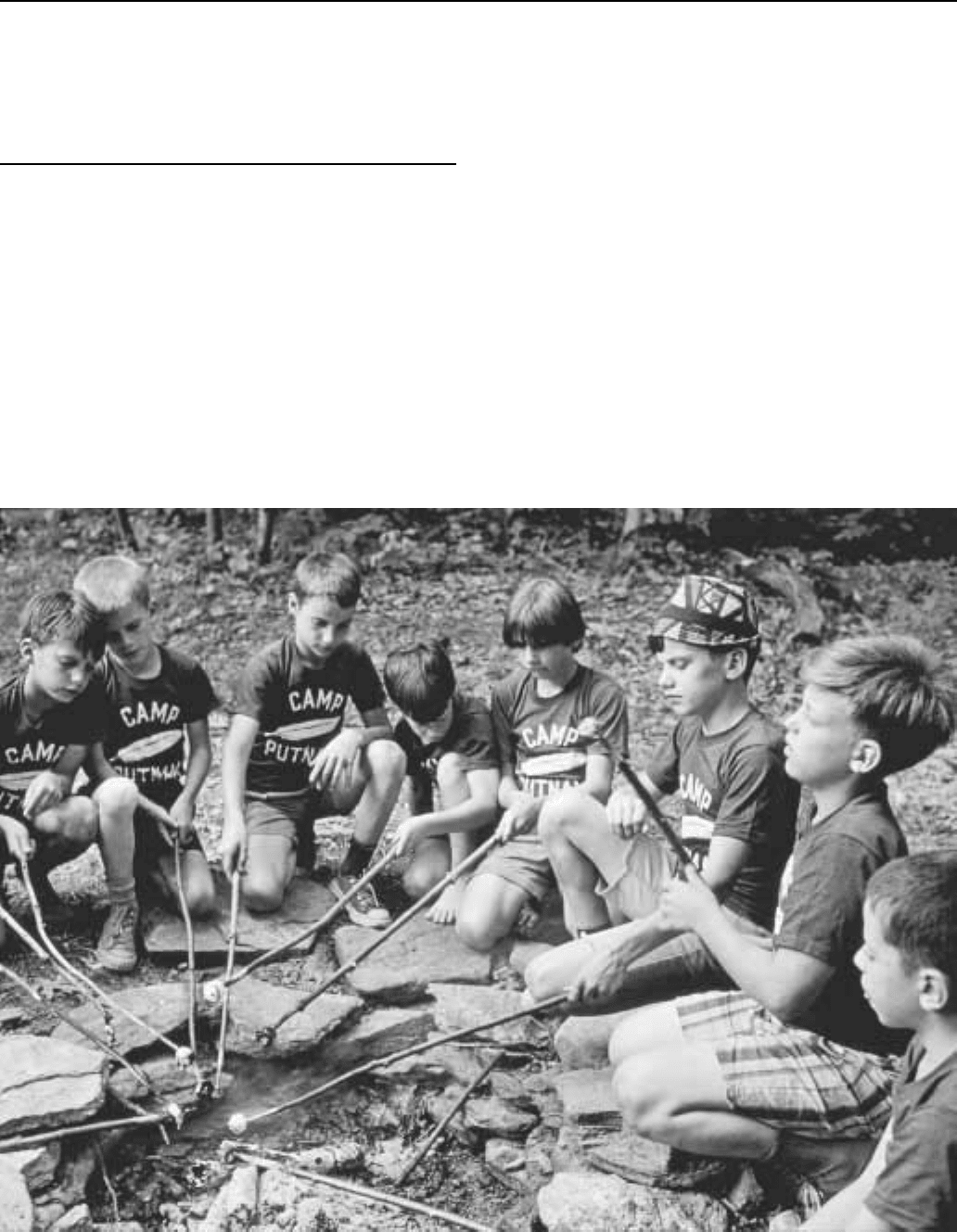Pendergast T., Pendergast S. St. James Encyclopedia of Popular Culture. Volume 1: A-D
Подождите немного. Документ загружается.


CAGNEYENCYCLOPEDIA OF POPULAR CULTURE
409
state on the emotional neglect of his parents during childhood. He
revealed that ‘‘On stage, I could hide behind the characters and
inanimate objects I created. Off stage, with my real personality for all
to see, I was a mess . . . I couldn’t believe that anyone could like me
for myself.’’
Despite his public proclamation of being cured, Caesar contin-
ued to suffer. After his second television program was taken off the air
in 1957 because it no longer could compete against ABC’s The
Lawrence Welk Show, the comedian’s mental and physical health
declined even further. Although he returned to television a few more
times during his career, he was never quite the same. During the 1960s
and 1970s he appeared in bit roles in movies such as Grease, History
of the World, Part I, and It’s a Mad, Mad, Mad, Mad World, but he
spent most of his time in isolation grappling with his problems. It
wasn’t until 1978 that he had completed his recovery. In his seventies
he continued to nurture a small but respectable movie career in The
Great Man Swap and Vegas Vacation, but he remained best known
as one of the most intelligent and provocative innovators of
television comedy.
—Susan Murray
F
URTHER READING:
Adair, Karen. The Great Clowns of American Television. New York,
McFarland, 1988.
Caesar, Sid. Where Have I Been? An Autobiography. New York,
Crown Publishers, 1982.
Caesar, Sid, as told to Richard Gehman. ‘‘What Psychoanalysis Did
for Me.’’ Look. October 2, 1956, pp. 49, 51-52.
Davidson, Bill. ‘‘Hail Sid Caesar!’’ Colliers. November 11, 1950,
pp. 25, 50.
Cagney and Lacey
The arrival of Cagney and Lacey in 1982 broke new and
significant ground in television’s ever-increasing proliferation of
popular cop series in that the stars were women—a pair of undercover
detectives out there with New York’s finest, unafraid to walk into the
threat of violence, or to use a gun when necessary. Effectively, writers
Barney Rosenzweig, Barbara Avedon and Barbara Corday offered
audiences a female Starsky and Hutch, cleverly adapting the nuances
of male partner-and-buddy bonding to suit their heroines. Although
jam-packed with precinct life and crime action, the series was
character driven, with careful attention given to the private lives of the
two detectives, sharply contrasted for maximum interest in both the
writing and the casting. Mary Beth Lacey, dark-haired, New York
Italian working-class, combined her career with married life and the
struggle to raise her children; Christine Cagney, more sophisticated,
more ambitious, single, blonde, and very attractive, struggled with a
drinking problem. The relationships between them and their male
colleagues were beautifully and realistically brought to life by Tyne
Daly and Sharon Gless, respectively. Gless was a late addition,
brought in to counter criticisms that the show was too harsh and
Sharon Gless (left) and Tyne Daly in a scene from the television movie
Cagney and Lacey: The Return.
unfeminine: Loretta Swit had played Cagney in the pilot, followed by
Meg Foster in the short first series, which failed to find favor in its
depiction of women in so unglamorous a context. However, with
Gless in tow, the show’s treatment of female solidarity and hard-
hitting issues won the CBS show a huge popular following, and lasted
for seven seasons until 1988.
—Nickianne Moody
F
URTHER READING:
Fiske, John. ‘‘Cagney and Lacey: Reading Character Structurally and
Politically.’’ Communication. Vol. 9, No. 3/4, 1987, 399-426.
Cagney, James (1899-1986)
One of the greatest tough-guy personas of twentieth-century
film, James Cagney worked hard to refine his image to meet his
responsible Catholic background. The result was a complex set of
characters who ranged from the hard-working immigrant striving to
make his way in America, to the American hero of Cold War times
who fought to preserve our way of life against Communist infiltrators.
Cagney’s various personas culminated in one as different from the
others as can be imagined—he began to play characters on the edge of
(in)sanity. It is his image as a tough guy, however, that is most enduring.
In 1933, during the filming of Lady-Killer, Darryl F. Zanuck sent
a memo to his crew of writers in which he detailed the studio’s
requirements for the Cagney persona: ‘‘He has got to be tough, fresh,
hard-boiled, bragging—he knows everything, everybody is wrong
but him—everything is easy to him—he can do everything and yet it

CAGNEY ENCYCLOPEDIA OF POPULAR CULTURE
410
James Cagney in a scene from the film White Heat.
is a likeable trait in his personality.’’ During the 1930s, Cagney’s
uptempo acting style—the rat-a-tat-tat of his reedy voice—and his
distinctly Irish-puck appearance, created a decidedly lower-East side
aura. He was a city boy.
Cagney was born in New York City on July 17, 1899. Although
studio publicity promoted stories about a tough east-side upbringing
and life above a saloon, Cagney was, in fact, raised in the modest
middle-class neighborhood of Yorkville. Two of his brothers became
doctors. On screen, however, Cagney played tough guys—characters
who were immigrants fighting to fit in identified.
Public Enemy, Cagney’s first starring role, remains famous for
an enduring still of Cagney, with lips pursed, hair awry, and eyes
enraged, smashing a grapefruit in Mae Clarke’s face. But it was Tom
Powers’ contempt for assimilation that alarmed educators and re-
formers. In 1932, armed with the Payne Fund Studies, a group of
reformers feared that immigrant youths over identified with certain
screen stars and surrendered their parents’ values for falsely ‘‘Ameri-
canized’’ ones. In his popularization of the Payne report, Henry James
Forman echoed these fears when he identified one second-generation
Italian youth’s praise for Cagney: ‘‘I eat it. You get some ideas from
his acting. You learn how to pull off a job, how he bumps off a guy and
a lot of things.’’
Because of the uproar from reformers and the ascendancy of
President Roosevelt and his accompanying call for collective action,
Warner Brothers shifted their image of Cagney. He no longer embod-
ied lost world losers but common men fighting to make it in America.
And Cagney’s image of fighting to make it spoke to New York’s
immigrants (Italians, Jews, Poles, Slavs), who in 1930 comprised
54.1 percent of New York City’s households. From 1932-39 (a period
in which he made 25 films), Cagney represented an ethnic in-
between. As an Irish-American, he was an icon for immigrants
because he represented a complex simultaneity—he was both a part of
and apart from Anglo-Saxon society. In a series of vehicles, Cagney
was the outlaw figure, a character who did not want to conform to the
dictates of the collective, and yet, through the love of a WASPish
woman or the demands of the authoritative Pat O’Brien (the Irish cop
figure in Here Comes the Navy [1934] and Devil Dogs of the Air
[1935]) Cagney harnessed his energies to communal good.

CAKEWALKSENCYCLOPEDIA OF POPULAR CULTURE
411
Regardless of how Cagney’s image was read by immigrants,
sociologists, and reformers, he was not happy with how he perceived
Zanuck and the Warner Brothers’ script writers had structured his
persona. A devout Catholic and a shy, soft-spoken man off-screen, he
was tired of roughing up women and playing street punks on screen.
Three times (1932, 1934, 1936) he walked off the studio lot to protest
his typecasting. In March 1936, Cagney won a breech of contract suit
against Warner Brothers, and later that year signed with Grand
National where he filmed Great Guy (1936) and Something to Sing
About (1937). Unfortunately, neither effort changed his persona, and
with Grand National falling into receivership, Cagney returned to
Warner Brothers.
To enhance Cagney’s return, Warner Brothers immediately
teamed him with old pal and co-star Pat O’Brien in Angels With Dirty
Faces (1938). As Rocky Sullivan, Cagney received an Academy
Award nomination and the New York Critics Award for best actor.
The film’s most memorable scene features Cagney’s death-row walk
in which his ‘‘performance’’ switches the Dead End Kids’ alle-
giances from one father figure (Cagney) to another (O’Brien). It is
an explosive moment of ambiguity in which a character destroys
his reputation for the audience in the film (the Kids) but gains,
through his sacrifice, saintliness from the audience in the theater
(largely immigrant).
By the 1940s, Cagney’s image had radically changed under the
pressures of the Martin Dies’ ‘‘Communist’’ innuendoes. With war
raging in Europe the competing images in Cagney’s persona (the
anarchic individual at odds with the collective; the Irish-American
trying to make it in WASP—White Anglo-Saxon Protestant—socie-
ty) were transformed into a homogenized pro-United States figure.
The plight of the immigrant was replaced by Warner Brothers’ all-
American front to the Axis. Yankee Doodle Dandy (1942) culminated
the change as Cagney was galvanized into a singing, dancing super-
patriot. Cagney won an Academy Award for this dynamic performance.
Following a second try at independence (United Artists, 1943-
48), the post-World War II Cagney struggled to maintain a contempo-
rary persona. Much of his New York City audience had grown up and
moved to the suburbs. Too old and lace-curtain Irish to remain an
ethnic in-between, the post-war Cagney bifurcated into two types: a
strong-willed patriarch or a completely insane figure who needed to
be destroyed. White Heat mirrored the switch in emphasis. No longer
was Cody Jarret fighting to realize the immigrant dream; instead he
fought a mother complex.
On March 18, 1974 more than 50 million Americans watched
Cagney accept the American Film Institute’s second annual life-time
achievement award. Although he had fought Zanuck, Wallis, and the
studio’s construction of his ‘‘tough, fresh, hard-boiled’’ image, he
embraced it during the tribute. In his acceptance speech Cagney
thanked the tough city boys of his past: ‘‘they were all part of a very
stimulating early environment, which produced that unmistakable
touch of the gutter without which this evening might never have
happened.’’ James Cagney died on Easter Sunday, 1986.
—Grant Tracey
F
URTHER READING:
Forman, Henry James. Our Movie Made Children. New York,
MacMillan, 1933.
Kirstein, Lincoln (as Forrest Clark). ‘‘James Cagney.’’ New Theater.
December, 1935, 15-16, 34.
McGilligan, Patrick. Cagney: The Actor as Auteur. San Diego, A.S.
Barnes, 1982.
Naremore, James. Acting for the Cinema. Berkeley, University of
California Press, 1988.
Sklar, Robert. City Boys: Cagney, Bogart, Garfield. New Jersey,
Princeton University Press, 1992.
Tynan, Ken. ‘‘Cagney and the Mob.’’ Sight and Sound. May,
1951, 12-16.
Cahan, Abraham (1860-1951)
The flowering of Jewish-American fiction in the 1950s and
1960s had its origin in the pioneering work of Abraham Cahan:
immigrant, socialist, journalist, and fiction writer. With William
Dean Howells’ assistance, Cahan published Yekl: A Tale of the New
York Ghetto (1896) and The Imported Bridegroom (1898). But it is
The Rise of David Levinsky (1917) that is his masterwork. Using
Howells’s Rise of Silas Lapham as his model, Cahan explores an
entire industry (ready-made clothing) and immigrant experience
(Eastern European Jews) by focusing on a single character and his
bittersweet ascent from Russian rags to Manhattan riches. A major
work of American literary realism, The Rise of David Levinsky is also
an example of reform-minded Progessivism and began as a series of
sketches in McClure’s Magazine alongside the work of muckrakers
Upton Sinclair and Ida Tarbell. Although he is best remembered for
this one novel (rediscovered in 1960 thanks to the popularity of a later
generation of postwar Jewish-American writers), Cahan’s most influ-
ential act was the founding of the world’s leading Yiddish newspaper,
the Jewish Daily Forward, in 1902.
—Robert A. Morace
F
URTHER READING:
Chametsky, Jules. From the Ghetto: The Fiction of Abraham Cahan.
Amherst, University of Massachusetts Press, 1977.
Marowitz, Sanford E. Abraham Cahan. New York, Twayne, 1996.
Cakewalks
An elegant and stately dance created by African slaves on
Caribbean and North American plantations, the cakewalk enjoyed a
long history. During slavery, plantation owners judged the dance and
the finest dancer was rewarded with a cake. It became the first
African-American dance to become popular among whites. The
cakewalk was features in several contexts including the minstrel show
finale, early black musicals including Clorindy, or The Origin of the
Cakewalk in 1898 and The Creole Show in 1899, and on ballroom
floors thereafter. The cakewalk embodied an erect body with a quasi-
shuffling movement that developed into a smooth walking step.
—Willie Collins
F
URTHER READING:
Cohen, Selma Jeanne, ed. International Encyclopedia of Dance. New
York, Oxford University Press, 1998.

CALDWELL ENCYCLOPEDIA OF POPULAR CULTURE
412
Emery, Lynne Fauley. Black Dance in the United States from 1619 to
1970. Palo Alto, California, 1972.
Caldwell, Erskine (1903-1987)
Although Erskine Caldwell gradually descended into obscurity,
during his heyday in the 1930s and 1940s his books were perennial
best-sellers. Notorious for the explicit sexuality in his novels about
Southern poor whites, Caldwell withstood several obscenity trials and
saw his work banned on a regular basis. Caldwell’s trademark
mixture of sex, violence, and black humor garnered various reactions.
Southerners in particular felt that Caldwell pandered to stereotypes of
the South as a land of ignorance, sloth, and depravity, but many
respected literary critics saw burlesque humor, leftist political activ-
ism, or uncompromising realism in Caldwell’s writing. Caldwell’s
major fiction included Tobacco Road (1932), God’s Little Acre
(1933), Kneel to the Rising Sun and Other Stories (1935), Trouble in
July (1940), and Georgia Boy (1943). In addition to novels and short
stories, Caldwell coauthored a number of photograph-and-text books
with his second wife, photographer Margaret Bourke-White, the most
popular of which were You Have Seen Their Faces (1937) and Say, Is
This the U.S.A.? (1941).
Caldwell was born in rural White Oak, Georgia. He inherited his
social conscience from his father, a minister in the rigorous Associat-
ed Reformed Presbyterian Church. Because of his father’s ministry,
Caldwell’s family moved frequently, and their financial situation was
often strained. Caldwell had little formal education. His mother
taught him at home during his early childhood, and he never formally
graduated from high school. He later spent brief periods at three
different colleges but never obtained a degree. After a long series of
odd jobs and some newspaper work for the Atlanta Journal, Caldwell
moved to Maine in 1927 to concentrate on writing fiction. He would
never again live in the South, though he made occasional visits for
documentary projects or creative inspiration.
Caldwell’s early years in Maine were spent in utter poverty. His
first three books attracted little attention, but his fourth, Tobacco
Road, defined his career and made him rich. Published in 1932,
Tobacco Road featured Jeeter Lester and family, a brood of destitute
sharecroppers in rural Georgia. The dysfunctional Lester clan starved
and stole and cussed and copulated throughout the book, which
initially received mixed reviews and posted lackluster sales. Jack
Kirkland changed all that when he translated Tobacco Road into a
phenomenally successful Broadway play. The play ran from Decem-
ber of 1933 through March of 1941, an unprecedented seven-year
stretch that was a Broadway record at the time. Touring versions of
the play traveled the nation for nearly two decades, playing to packed
houses throughout the country. Caldwell’s book sales skyrocketed.
Through the 1940s Caldwell’s books continued to sell well in
dime-store paperback versions with lurid covers, but reviews of his
new books were increasingly harsh. Though he continued writing at a
prolific pace, Caldwell was never able to repeat the critical success of
his earlier work. The quality of his work plummeted, and his
relationships with publishers and editors, often strained in the past,
deteriorated further.
Despite Caldwell’s waning literary reputation, he had a lasting
impact on American popular culture. A pioneer in the paperback book
trade, he was one of the first critically acclaimed writers to aggres-
sively market his work in paperback editions, which were considered
undignified at the time. Most of Caldwell’s astonishing sales figures
came from paperback editions of books that were first published in
hardback years earlier. These cheap editions were sold not in bookstores,
but in drug stores and magazine stands; consequently they reached a
new audience that many publishers previously had ignored. Sexually
suggestive covers aided Caldwell’s sales and forever changed the
marketing practices for fiction. His censorship battles made Caldwell
a pivotal figure in writers’ battles for First Amendment rights.
Without question, however, Caldwell’s greatest legacy has been his
depiction of Southern poor whites. The Lesters have been reincarnat-
ed in The Beverly Hillbillies, Snuffy Smith, L’il Abner, The Dukes of
Hazzard, and countless other poor white icons. Though its origin
seems largely forgotten, the term ‘‘Jeeter’’ survives as a slang
expression for ‘‘poor white trash.’’
—Margaret Litton
F
URTHER READING:
Cook, Sylvia Jenkins. Erskine Caldwell and the Fiction of Poverty.
Baton Rouge, Louisiana State University, 1991.
MacDonald, Scott, editor. Critical Essays on Erskine Caldwell.
Boston, G. K. Hall, 1981.
Miller, Dan B. Erskine Caldwell: The Journey from Tobacco Road.
New York, Knopf, 1995.
Mixon, Wayne. Erskine Caldwell: The People’s Writer. Charlottes-
ville, University of Virginia Press, 1995.
Silver, Andrew. ‘‘Laughing over Lost Causes: Erskine Caldwell’s
Quarrel with Southern Humor.’’ Mississippi Quarterly. Vol. 50,
No. 1, 1996-97, 51-68.
Calloway, Cab (1907-1994)
Known as ‘‘The Hi-De-Ho Man,’’ jazz singer, dancer, and
bandleader Cab Calloway was one of the best-known entertainers in
the United States from the early 1930s until his death in 1994.
Calloway’s musical talents, however, were only part of the story.
His live performances at Harlem’s Cotton Club became legendary
because of Calloway’s wild gyrations, facial expressions, and
entertaining patter.
Born Cabell Calloway on Christmas Day, 1907, in Rochester,
New York, Calloway spent most of his childhood years in Baltimore.
The younger brother of singer Blanche Calloway, who made several
popular records in the early 1930s before retiring, Cab discovered
show business during his teen years, frequenting Chicago clubs while
attending that city’s Crane School. When Calloway encountered
financial difficulties, he naturally turned to moonlighting in the same
clubs, first as an emcee and later as a singer, dancer, and bandleader.
Although Calloway was attending law school and his hopes for a
career in that field looked promising, he elected to drop out and try to
make it as a singer and dancer. He led a successful Chicago group, the
Alabamians, who migrated to New York but found the competition

CALVIN AND HOBBESENCYCLOPEDIA OF POPULAR CULTURE
413
Cab Calloway
too harsh to survive. Calloway had better luck with his next group, the
Missourians, appearing in the Broadway revue Connie’s Hot Choco-
lates in 1929.
Soon after, Calloway was offered a position as the headline act at
the Cotton Club, and he readily accepted. He also had begun record-
ing, and in 1931 produced his best-known single, ‘‘Minnie the
Moocher.’’ Minnie and her companion, Smokey Joe, were the first of
many fictional characters Calloway invented to entertain his audi-
ences. He continued Minnie’s saga with such ‘‘answer’’ records as
‘‘Minnie the Moocher’s Wedding Day’’ and ‘‘Mister Paganini,
Swing for Minnie,’’ which took a satirical look at classical music. He
continued to develop his talents as a jazz singer and was one of the
first ‘‘scat’’ singers, improvising melodies while singing nonsense
lyrics. Blessed with a wide vocal range, Calloway employed it to his
fullest advantage, especially on his famous ‘‘hi-de-ho’’ songs, which
included ‘‘You Gotta Hi-De-Ho’’ and the ‘‘Hi-De-Ho Miracle Man.’’
Calloway’s orchestra was a showcase and proving ground for
some of the most prominent musicians in the history of jazz. Walter
‘‘Foots’’ Thomas, Doc Cheatham, Danny Barker, Dizzy Gillespie,
and Ike Quebec, among many others, gained notoriety by appearing
with Calloway, who paid higher salaries—and demanded better
work—than any other bandleader.
Calloway had so much visual appeal that he was cast in several
movies, including Stormy Weather (1943). More recently, Calloway
played a thinly veiled version of himself in the 1980 blockbuster The
Blues Brothers, dispensing fatherly advice to protagonists Jake and
Elwood Blues (John Belushi and Dan Aykroyd) as well as turning in a
spectacular performance of ‘‘Minnie the Moocher’’ at the film’s climax.
Although the single ‘‘Blues in the Night’’ was a major hit in
1942, Calloway found little commercial success after the Depression
years. With the end of the big-band era after World War II, Calloway
reluctantly disbanded his orchestra in 1948 and thereafter performed
solo or as a featured guest in other groups. His love of entertaining led
him to continue performing for fans until his death in 1994.
—Marc R. Sykes
F
URTHER READING:
Calloway, Cab, and Bryant Rollins. Of Minnie the Moocher and Me.
New York, Crowell, 1976.
Calvin and Hobbes
Imaginative, hilariously drawn, at times philosophical—all the
while retaining a child’s perspective— this daily and Sunday comic
strip has been compared to the best of the classic comics. Written and
drawn by Bill Watterson, Calvin and Hobbes debuted in 1985 and
featured the adventures of Calvin, a hyperactive, overly imaginative,
bratty six-year-old, and his best friend, the stuffed tiger Hobbes.
Other regularly appearing characters included Calvin’s stressed out
parents; Susie Derkins, the neighborhood girl; Miss Wormwood, the
much put-upon school teacher; Mo, the school bully; and Rosalyn, the
only baby-sitter willing to watch Calvin.
Part of the charm of the strip was the fact that Watterson often
blurred the distinction between what was imaginary and what was
‘‘real.’’ Calvin saw his tiger as real. When Calvin and Hobbes were
by themselves, Watterson drew Hobbes as a walking tiger with fuzzy
cheeks and an engaging grin. When another character appeared with
Calvin and Hobbes, Hobbes was drawn simply as an expressionless
stuffed tiger. The ‘‘real’’ Hobbes was more intellectual than Calvin
and also liked to get ‘‘smooches’’ from girls, unlike the girl-hating
Calvin (though both were founding members of G.R.O.S.S.—Get Rid
of Slimy girlS).
Unlike Dennis the Menace, Calvin and Hobbes went beyond the
hijinks of a holy terror. It explored childhood imagination and the
possibilities of that imagination. For instance, one of Calvin’s chief
toys besides Hobbes was a large cardboard box. When it was right
side up, the box was a time machine that transported Calvin and
Hobbes back to the Jurassic. When Calvin turned it over, the box
became the transmogrifier, which could transmogrify, or transform,
Calvin into anything he wished. The transmogrifier was later convert-
ed into a duplicator, producing lots of Calvins. Imagination sequences
such as these have been imitated by other comic strips such as Jim
Borgman and Jerry Scott’s Zits.
Calvin’s imaginary world contained other memorable characters
and devices. Calvin became the fearless Spaceman Spiff whenever he
needed to escape the doldrums of school or the rebuke of his parents,
who clearly loved but did not always like Calvin, a view of the family
different from many others seen on the comics page. Calvin would
don a cape and cowl and become Stupendous Man. His repertoire also
included a tyrannosaur, or Calvinosaur, a robot, and a werewolf.
Calvin also liked to sit in front of the television set, a behavior
Watterson satirized, evidencing his contempt of television as opposed
to personal imagination.
Most of the strips featured Calvin’s antics, such as hitting Susie
with a snowball or running away from his mother at bath time. Other

CAMACHO ENCYCLOPEDIA OF POPULAR CULTURE
414
common gags included his reluctance to eat dinner, his hatred of
school and homework, and his antagonism toward Rosalyn. Calvin
also enjoyed building deformed or dismembered snowmen on the
front lawn. Besides these gags, though, the strip would at times deal
with the philosophical nature of humanity as seen by a child and a
tiger. Given the names of the characters, this was only to be expected.
The comic strip’s title characters are named after John Calvin and
Thomas Hobbes. Calvin was a Protestant reformer famous for his
ideas on predestination and the sovereignty of God. Calvin believed
men, and children, to be sinners. Hobbes, author of the Leviathan,
believed in submission to the sovereign of the state, since he too
believed men were evil. Watterson occasionally commented on such
issues between his two characters, usually as they headed down a hill
in either a wagon or a sled.
Watterson ended Calvin and Hobbes in 1995. Watterson was
known to dislike the deadlines, commercialization, and restraints of
syndicated comics, which most likely motivated his retirement. While
Watterson never permitted merchandising of his Calvin and Hobbes
characters, Calvin and Hobbes reprints remained in stores, and Calvin
images, though most likely unlicensed, continued to be displayed in
cars and trucks. Calvin and Hobbes collections include Something
under the Bed Is Drooling (1988), Yukon Ho! (1989), and The Calvin
and Hobbes Lazy Sunday Book (1989).
Like Gary Larson of The Far Side, Watterson had a unique honor
bestowed on him by the scientific community. On one adventure,
Calvin and Hobbes explored Mars. When the Mars Explorer sent back
pictures of Mars, NASA scientists named two of the Mars rocks
Calvin and Hobbes.
—P. Andrew Miller
F
URTHER READING:
Holmen, Linda, and Mary Santella-Johnson. Teaching with Calvin
and Hobbes. Fargo, North Dakota, Playground Publishing, 1993.
Kuznets, Lois Rostow. When Toys Come Alive. New Haven, Con-
necticut, Yale University Press, 1994.
Watterson, Bill. Calvin and Hobbes. New York, Andrews and
McMeel, 1987.
Camacho, Héctor ‘‘Macho’’ (1962—)
In 1985, boxer Héctor Camacho, known for his flashy style and
flamboyant costuming as a ‘‘Macho Man’’ and ‘‘Puerto Rican
Superman,’’ became the first Puerto Rican to have won the World
Boxing Championship (WBC) and World Boxing Organization (WBO)
championships in the lightweight division. Born in Bayamón, Puerto
Rico, in 1962, Camacho won 40 of his first 41 fights culminating with
his victory over José Luis Ramos for the WBC lightweight champion-
ship. In 1987, Camacho moved up to the super lightweight division, in
which he fought only seven sluggish battles before retiring in 1994.
The two highlights of this latter career were his victory over World
Boxing Association (WBA) lightweight champion Ray ‘‘Boom Boom’’
Mancini in 1989 and his 1992 fight with Julio César Chávez for a $3
million payoff.
—Nicolás Kanellos
Héctor “Macho” Comacho
FURTHER READING:
Tardiff, Joseph T., and L. Mpho Mabunda, editors. Dictionary of
Hispanic Biography. Detroit, Gale, 1996.
Camelot
Camelot, a musical by Alan Jay Lerner and Frederick Loewe
based on T.H. White’s version of the Arthurian romance The Once
and Future King, was one of the most successful Broadway musicals
of the 1960s. The original production starred Julie Andrews, Richard
Burton, and Robert Goulet. Songs included ‘‘I Wonder What the King
Is Doing Tonight,’’ ‘‘Camelot,’’ ‘‘How to Handle a Woman,’’
‘‘C’est Moi,’’ and ‘‘If Ever I Would Leave You.’’ The 1967 film
version featured Richard Harris, Vanessa Redgrave, and Franco
Nero. Camelot contemporized the era of King Arthur and made the
legend accessible and appealing to 20th-century audiences through
the use of 1960s popular music styles, a skillful libretto, and well-
known performers. The influence of Camelot extended well beyond
the musical theater. It became a symbol of the administration of
President John F. Kennedy, an era—like that of King Arthur—whose
days were cut tragically short. The Oxford History of the American

CAMPENCYCLOPEDIA OF POPULAR CULTURE
415
People (1965) even ends with a quote from the show: ‘‘Don’t let it be
forgot that once there was a spot, for one brief shining moment that
was known as Camelot.’’
—William A. Everett
F
URTHER READING:
Citron, Stephen. The Wordsmiths: Oscar Hammerstein 2nd & Alan
Jay Lerner. New York, Oxford University Press, 1995.
Everett, William A. ‘‘Images of Arthurian Britain in the American
Musical Theater: A Connecticut Yankee and Camelot.’’ Sonneck
Society Bulletin. Vol. 23, No. 3, 1997, 65, 70-72.
Lerner, Alan Jay. The Street Where I Live. New York, W.W.
Norton, 1970.
Camp
‘‘Camp asserts that good taste is not simply good taste; that there
exists, indeed, a good taste of bad taste.’’ In her well known 1964
piece, Notes on Camp, Susan Sontag summarized the fundamental
paradox that occupies the heart of ‘‘camp,’’ a parodic attitude toward
taste and beauty which was at that time emerging as an increasingly
common feature of American popular culture. Avoiding the drawn-
out commentary and coherence of a serious essay format, Notes on
Camp dashes off a stream of anecdotal postures, each adding its own
touches to an outline of camp sensibility. ‘‘It’s embarrassing to be
solemn and treatise-like about Camp,’’ Sontag writes. ‘‘One runs the
risk of having produced a very inferior piece of Camp.’’ And she was
right. To take camp seriously is to miss the point. Camp, a taste of bad
taste which languishes between parody and self parody, doesn’t try to
succeed as a serious statement of taste, but stages its own failure as
taste by doing and overdoing itself. In this way, failure is camp’s
greatest triumph and to take it away through a serious analysis would,
for Sontag, be tantamount to an annihilation of the subject. In fact,
since camp’s self-parody leaves no durable statement of taste, it
should only be spoken of as a verb: ‘‘camping,’’ the act of subverting
a taste by exaggerating its pomp and artifice to the point of absurdity.
Writing in 1964, Sontag already had a short history of popular
camp to reflect upon. From the mid 1950s, a peculiar sense of the
beauty of bad taste had crept into American culture thorough the
pages of MAD magazine and the writings of Norman Mailer—a
parodic smirk that would creep across the face of counter culture of
the 1960s and ultimately etch itself deeply into the American cultural
outlook. By the mid 1960s, camp’s triumphs were many: the glib,
colorful, and disposable styles of Pop gave way to the non-conformity
of hippie camp, which in turn inspired 1970s glam-rock camp, the
biting camp of punk and the irony and retro of the 1980s and 1990s
camp, while throughout the inflections of gay and drag camp were
never far away. In each case, camp’s pattern is clear: camp camps
taste. Less a taste in itself, more an attitude toward taste in general,
camp’s failed seriousness exaggerates to absurdity the whole posture
of serious taste, it ‘‘dethrones seriousness,’’ and reveals the vanity
and folly that underlies every expression of taste. And camp’s failure
is contagious. By affirming style over substance, the artifice of taste
over the content of art, and by undermining one’s own posture of good
taste by exaggerating its vanity and affect, camp exposes the lie of
taste in general—without confronting it with a superior standard.
Sontag writes: ‘‘Camp taste turns its back on the good-bad axis of
ordinary aesthetic judgment. Camp doesn’t reverse things. It doesn’t
argue that the good is bad or the bad is good. What it does is to offer
for art (and life) a different—a supplementary—set of standards.’’
Free from seriousness, camp can be cruel or kind: at moments camp
offers a boundless carnival of generosity to anyone willing to don a
disguise and share in the pomp and pretense that is taste, while at other
moments camp’s grotesque vanity might fly into jealous rage at the
competitor, the campier than thou, that threatens to rain on the charade.
Sontag traces camp to its origins as a gay sensibility in the
writings of Oscar Wilde and Jean Genet, who sought to dethrone the
seriousness of Victorian literary convention and the tastes of the
French bourgeoisie. In America, camp largely emerged from the need
to dethrone the conformity and banality of the consumer culture of the
1950s. ‘‘Pop’’ styles sprang out of a reaction to the conformity
imposed by the mass-produced culture provided by a ‘‘society of
abundance,’’ which unconvincingly advocated the virtues and pleas-
ures of life in a world of consumer goods. By the 1960s, that promise
was less and less convincing, and the adornments of the suburban
home seemed sadly inadequate as stand-ins for human satisfaction.
The colorful, flamboyant and garish styles of ‘‘Pop’’ provided some
relief for an American middle class increasingly inundated with
‘‘serious’’ consumer tastes in which it had no trust. In Britain a group
of painters calling themselves The International Group (whose mem-
bers included Richard Hamilton, John McHale, and Magda Cordell)
set out to sing the praises of the new culture of plenty in a slightly off-
key refrain: Hamilton’s famous 1956 collage of a suburban living
room asks with a conspicuous sincerity, ‘‘Just What Is It That Makes
Today’s Homes So Different, So Appealing?’’ The piece lampoons
the optimism and complacency of the new domestic bliss, while
celebrating its artifice. Camping the Americanization of the 1950s,
British Pop spread quickly to the garrets of New York where Roy
Lichtenstein, Jasper Johns, and Andy Warhol quickly picked up the
trick of praising the land of opulence with the tongue squarely in
the cheek.
‘‘Pop’’ resonated in the mainstream of American cultural life
with the first of what would be many terrifically successful British
Invasions. Dethroning the ‘‘good taste’’ of mass culture with stylish
overkill, pop clothing, decoration, and graphics were exaggerated,
colorful and garish, silly and trite. The fashions of Mary Quant, the
photography of David Bailey, and ultimately the music of the Rolling
Stones and the Beatles offered stylistic excess as the antidote to the
‘‘square’’ tastes of the older generation. The pop-psychedelic expres-
sions of later years would confirm the superiority of mockery over
taste. The fad Vogue dubbed ‘‘Youthquake’’ trumpeted the shallow
excessiveness of a youthful taste as an endorsement of style over
substance—a camping of mass culture. Commercial imagery, camped in
this way, shaped the counter culture of the 1960s, from the Beatles’
Sergeant Pepper album cover to Warhol’s soup cans to the garish
colors of psychedelic attire to the magazine clipping collages that
covered many a teenager’s bedroom walls: camping was at once
subversive, clever, and affirming of one’s taste for bad taste. One
image in particular expresses this camping of mass culture that was
the achievement of Pop: Twiggy, the slim and youthful British model
who took Madison Avenue by storm in 1967, was pictured in a New
Yorker article posing in Central Park, surrounded by children, all of
whom wore Twiggy masks, photographic representations of the face
of the model. Camping the artifice of mass stardom had become part
of stardom itself.

CAMPBELL ENCYCLOPEDIA OF POPULAR CULTURE
416
It was, however, the camp of the drag queen that would ultimate-
ly triumph in the counter culture, and claim the camp legacy for the
next decade. As early as Warhol’s Factory days, where Manhattan
drag queens like Candy Darling and Holly Woodlawn were featured
prominently in such films as Chelsea Girls (1966), drag had always
had a cozy relationship with the counter culture. The relationship
became closer after the Stonewall riots of 1969, when drag style
emerged as the motif that gave rock a disturbing and intriguing gender
ambiguity. By the early 1970s, rock became increasingly open to
camp inflections of drag: Mick Jagger developed a strutting, effemi-
nate stage presence; David Bowie, Elton John, and Alice Cooper
brought excess and artifice together with gender ambiguity that was
taken directly from lively drag scenes and the queens who populated
the 1970s gay scene. The raucous screenings of Jim Sharman’s 1974
Rocky Horror Picture Show and John Waters’ 1973 Pink Flamingos
remain an enduring rite of college frat life.
As the 1970s wore on, New Wave and Punk movements drew on
camp’s preoccupation with dethroning the seriousness of taste. Such
early punk acts as the New York Dolls sharpened the whimsy of
Sharman’s Dr. Frankenfurter character into a jarring sarcasm, less
playful and flamboyant, more the instrument of an outraged youth,
cornered by the boredom and banality of a co-opted counter-culture, a
valueless society and the diminished hopes of a job market plagued by
economic recession. Unlike the witticisms of Wilde and the flourish
of Marc Boland and other dandies of glam rock, Punk’s version of
camp was meant to sting the opponent with a hideous mockery of
consumer pleasure. The Sex Pistols’ Holiday in the Sun album begins
with a droning comment on low budget tourism: ‘‘cheap holiday in
other people’s misery,’’ while the B-52s’ manic celebration of the
faux leisure of consumerism chided the ear with shrill praises of
‘‘Rock Lobster’’ and ‘‘Girls of the U.S.A.’’ Punk camp, however,
would have to be de-clawed before it could achieve mainstream
influence, which ultimately happened in the early 1980s with the
invasion (again from Britain) of such campy ‘‘haircut’’ acts as Duran
Duran and Boy George’s Culture Club. The effect of punk camp on
American popular culture has yet to be fully understood, though it
seems clear that ironic distance (cleansed of punk’s snarl) became a
staple of the culture of the 1980s and 1990s. Retro (a preferred terrain
of camp, which finds easy pickings in tastes already rendered ‘‘bad’’
by the relentless march of consumer obsolescence) preoccupied the
1980s, where the awkward styles of the 1950s could be resurrected in
such films as Back to the Future, and every aging rock star from Paul
McCartney to Neil Young could cop a 50s greaser look in an effort to
appear somehow up to date, if only by appealing to the going mode
of obsolescence.
If irony and detachment had by the 1990s become defining
features of the new consumer attitude, the camping of America is
partly to blame, or credit. However, the 1990s also witnessed an
unprecedented mainstreaming of drag in a manner quite different
from that of the 1970s. In the 1990s, figures like Ru Paul and films
like Wigstock signaled the visibility of drag styles worn by the drag
queens themselves, not by straight rockstars taking a walk on the wild
side. That drag could metamorphose over twenty years from a
psychological aberration and criminal act to a haute media commodi-
ty testifies to the capacity of American culture to adjust to and absorb
precisely those things it fears most. In the camping of America, where
the abhorrent is redeemed, the drag queen fares well.
—Sam Binkley
F
URTHER READING:
Roen, Paul. High Camp: A Gay Guide to Camp and Cult Films. San
Francisco, Leyland Publications, 1994.
Ross, Andrew. ‘‘Uses of Camp.’’ In No Respect: Intellectuals and
Popular Culture. New York, Routledge, 1989.
Sontag, Susan. ‘‘Notes on Camp.’’ In Against Interpretation. New
York, Laurel, 1966.
Campbell, Glen (1936—)
After establishing himself as a reputable session guitarist for acts
including the Monkees and Elvis Presley in the early 1960s, Glen
Campbell came into his own as a country vocalist with a decided pop
twist. Delivering pieces by ace songwriters like Jimmy Webb, Camp-
bell’s hit singles of the mid-1960s—most notably ‘‘Witchita Line-
man’’ and ‘‘By the Time I Get To Phoenix’’—fused the steel guitar
sound of country with lilting string arrangements. By the early 1970s,
Campbell had placed a number of singles in the upper tiers of both pop
and country charts, and was even given the helm of his own popular
variety show, The Glen Campbell Good Time Hour, but after ‘‘South-
ern Nights,’’ his final number one hit, Campbell kept a relatively
low profile.
—Shaun Frentner
F
URTHER READING:
Campbell, Glen, with Tom Carter. Rhinestone Cowboy: An Autobiog-
raphy. New York, Villard, 1994.
Campbell, Naomi (1971—)
Discovered while shopping in 1985, British model Naomi Camp-
bell became an instant success in the United States, where she
metamorphosed from a sweet schoolgirl into a polished—and, many
would say, primadonna—professional. Her long dark hair, fey eyes,
and feline figure established her as the first and for a long time the
only black supermodel; her looks were distinctively African in origin
but appealed to conservative Caucasian consumers as well. Her 1994
novel about the fashion business, Swan, focused primarily on white
characters but made an impassioned argument in favor of widening
modeling’s ethnic base; she also recorded an album and starred in
other artists’ music videos. Guarding her stardom jealously, Camp-
bell sometimes refused to appear in fashion shows alongside other
black models, and she was known for making outrageous demands for
hotel rooms and entertainment. Campbell eventually had to face
accusations of abuse from modeling agencies and a former assistant.
—Susann Cokal
F
URTHER READING:
Campbell, Naomi. Swan. London, Heinemann, 1994.
Gross, Michael. Model: The Ugly Business of Beautiful Women. New
York, William Morrow & Company, 1995.

CAMPINGENCYCLOPEDIA OF POPULAR CULTURE
417
Tresniowski, Alex. ‘‘Out of Fashion.’’ People. November 23,
1998, 132-40.
Camping
Humans tamed the first campfires over 500,000 years ago, and
the word ‘‘camp’’ itself comes from the Latin campus, or ‘‘level
field,’’ but recreational camping as a popular cultural practice did not
emerge in the United States until the end of the nineteenth century,
when large numbers of urban residents went ‘‘back to nature,’’
fleeing the pressures of industrialization and increased immigration
for the temporary pleasures of a primitive existence in the woods.
The camping movement began in earnest in the mid-nineteenth
century, when upper-class men from New York, Boston, and other
northeastern cities traveled to the Catskills, the Adirondacks, and the
White Mountains to hunt, fish, and find solace in the beauty and
sublimity of untrammeled nature. Encouraged by such books as
William H. H. Murray’s Adventures in the Wilderness; or, Camp-life
in the Adirondacks (1869), these men sought to improve their moral
A group of boys at camp toasting marshmallows over an open fire.
and physical health and test their masculinity against the wilderness,
much as their working-class brethren had tested it on the battlefields
of the Civil War. They also set the tone of nostalgic nationalism that
would characterize camping throughout the twentieth century, identi-
fying themselves with idealized images of the pioneer frontiersmen as
rugged individualist and the American Indian as Noble Savage.
By the end of the nineteenth century, and especially after the
‘‘closing of the frontier’’ in 1890, camping had developed into an
established middle-class activity, one that relied as much on cities and
industries as it sought to flee them. Its increasing popularity could be
seen in the formation of outdoor clubs, such as the Boone and
Crockett Club (1887) and the Sierra Club (1892); the publication of
camp manuals, such as George W. Sears’s Woodcraft (1884) and
Horace Kephart’s Camping and Woodcraft (1906); and the appear-
ance of related periodicals, such as Forest and Stream (1873), Outing
(1882), and Recreation (1894). Easy access to remote areas was made
possible by the railroads, and the growth of the consumer culture—as
evidenced by the development of department stores, such as Mont-
gomery Ward (1872), and the mail-order business of Sears, Roebuck
(1895)—provided campers with the proper gear for their wilderness
voyages. At the same time, however, many campers supported the

CANCER ENCYCLOPEDIA OF POPULAR CULTURE
418
conservation and preservation movements, which helped to establish
the first national parks and forests.
The same forces of urbanization and industrialization that influ-
enced the popularity of recreational camping among adults also
affected the development of organized camping for children and
young people. Although a long summer vacation made sense for a
rural, agricultural population, technological advancements, and the
expansion of the cities made this seasonal break from compulsory
education increasingly obsolete in the late nineteenth century. Never-
theless, many schools continued to close for the months of June, July,
and August, and parents, educators, and church leaders were forced to
look elsewhere for ways to keep children occupied during the hot
summer months. Camp provided the perfect solution.
The first organized camping trip in the United States is said to
have occurred in 1861, when Frederick William Gunn and his wife
supervised a two-week outing of the Gunnery School for Boys in
Washington, Connecticut, but the first privately operated camp did
not appear until 1876, when Joseph Trimble Rothrock opened a camp
to improve the health of young boys at North Mountain in Luzerne
County, Pennsylvania. The oldest continuously operating summer
camp in the United States—‘‘Camp Dudley,’’ located on Lake
Champlain—was founded in 1886 by Sumner F. Dudley, who had
originally established his camp on Orange Lake, near Newburgh,
New York. By 1910, the organized camping movement had grown
extensive enough to justify the founding of the American Camp-
ing Association, which by the 1950s boasted more than five
thousand members.
Classifiable as either day camps or residential camps, summer
camps have generally provided a mixture of education and recreation
in a group-living environment in the out-of-doors, and their propo-
nents have claimed that the camps build character, encourage health
and physical fitness, enhance social, psychological, and spiritual
growth, and foster an appreciation for the natural world. The majority
of camps have been run by nonprofit organizations, such as the Boy
and Girl Scouts, Camp Fire Girls, Boys’ and Girls’ Clubs, 4-H Clubs,
Salvation Army, YMCA, YWCA, YM-YWHA, and churches, syna-
gogues, and other religious groups. Others have been private camps
run by individuals and corporations, or public camps run by schools,
municipal park and recreation departments, and state and federal
agencies. Especially notable in the twentieth century has been the
advent of innumerable special-interest camps, such as Christian and
Jewish camps, sports camps, computer camps, language camps, space
camps, weight-loss camps, and camps for outdoor and arts education.
Recreational camping developed in parallel with organized
camping in the early twentieth century, influenced in part by the
popularity of such nature writers as Henry David Thoreau, John Muir,
and John Burroughs. Equally influential was the mass-production of
the automobile and the creation of the modern highway system, which
led to the development of motor camping and the formation of such
organizations as the American Automobile Association, the Recrea-
tional Vehicle Association, and the Tin Can Tourists of America. The
growth of camping reached a milestone in the 1920s, with camping
stories being written by Ernest Hemingway and Sinclair Lewis; new
products being developed by L. L. Bean and Sheldon Coleman
(whose portable gas stove appeared in 1923), and the first National
Conference on Outdoor Recreation being held in 1924.
The postwar suburbanization of the United States, combined
with advances in materials technology and packaging, helped to turn
camping into a mass cultural activity in the late twentieth century, one
whose popularity not only affected the management of natural areas
but also called into question its own reason for being. Nearly ten
million recreational vehicles, or RVs, were on the road in the late
1990s, forcing national parks to install more water, sewer, and power
lines and close less desirable tent-camping sites. Meanwhile, the
introduction of aluminum-frame tents in the 1950s, synthetic fabrics
in the 1960s, freeze-dried foods in the 1970s, chemical insect repel-
lents in the 1980s, and ultra-light camp stoves in the 1990s allowed
campers to penetrate further into the backcountry, where they often
risked disturbing ecologically sensitive areas. With the invention of
cellular telephones and global positioning satellites, however, many
campers have begun to wonder whether their days as primitive
recreators may in fact be numbered, and whether it will ever again be
possible to leave technology and civilization behind for the light of an
evening campfire and the silence of a beeperless world.
—Daniel J. Philippon
F
URTHER READING:
Belasco, Warren James. Americans on the Road: From Autocamp to
Motel, 1910-1945. 1979. Baltimore, Johns Hopkins University
Press, 1997.
Eells, Eleanor. History of Organized Camping: The First 100 Years.
Martinsville, Indiana, American Camping Association, 1986.
Joselit, Jenna Weissman, ed. A Worthy Use of Summer: Jewish
Summer Camping in America. With Karen S. Mittelman. Intro.
Chaim Potok. Philadelphia, National Museum of American Jew-
ish History, 1993.
Kephart, Horace. Camping and Woodcraft: A Handbook for Vacation
Campers and Travelers in the Wilderness. Rev. ed. Intro. Jim
Casada. 1917. Knoxville, University of Tennessee Press, 1988.
Kraus, Richard G., and Margaret M. Scanlin. Introduction to Camp
Counseling. Englewood Cliffs, New Jersey, Prentice-Hall, 1983.
Schmitt, Peter J. Back to Nature: The Arcadian Myth in Urban
America. Foreword by John R. Stilgoe. 1969. Baltimore, Johns
Hopkins University Press, 1990.
Cancer
Cancer is not a single disease, but rather a monster with many
faces. Doctors and scientists have listed more than 200 varieties of
cancer, each having different degrees of mortality, different means of
prevention, different hopes for a cure. Carcinomas hit mucous mem-
branes or the skin, sarcomas attack the tissues under the skin, and
leukemia strikes at the marrow—and these are just a few varieties of
cancer. Cancers are all characterized by an uncontrolled proliferation
of cells under pre-existing tissues, producing abnormal growths. Yet
popular attitudes toward cancer have been less bothered with medical
distinctions than with providing a single characterization of the
disease, evoking a slow and painful process of decay that comes as a
sort of punishment for the patient. ‘‘Cancerphobia’’ is, as Susan
Sontag and James T. Patterson have shown, deeply rooted in
American culture.
Cancer is a very ancient disease, dating back to pre-historic
times. Archeological studies have allowed scientists to detect breast
cancer in an Egyptian mummy, while precise descriptions of different
